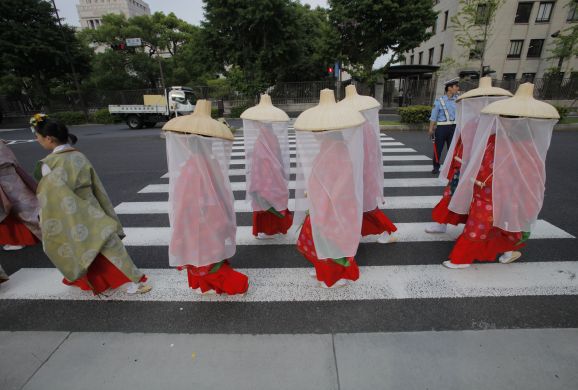JNTO (Japan National Tourism Organization) has this to say about the festival:
Dates: June 9th-16th
Place: Hie-jinja Shrine
City: Nagata-cho, Chiyoda-ku, Tokyo
The Sanno Matsuri is famous as a festival permitted by the Shogun to enter the grounds of Edo Castle during the Edo Period (1603-1867), along with the Kanda Matsuri. It was also one of the three largest festivals of Japan. The main procession called jinkosai takes place in the middle of June in every other year according to the Western calendar.
About 300 people dressed in ancient costumes parade through the heart of Tokyo including Tokyo Station, Ginza, and in front of the Diet Building. Consisting of mikoshi (portable shrines) adorned with a phoenix on the roof, dashi floats, people carrying drums, people on horseback, the procession extends over a length of 600 meters. You will also see people dressed as the legendary goblin called Tengu, characterized by a red face and a long nose, and believed to possess supernatural powers. The procession which departs from Hie-jinja Shrine at 8 o’clock in the morning does not return to the shrine until early in the evening.
*******************************************
The Japan Times today also carries an article with a slideshow/video which can be seen here.
Although the Sanno Festival occurs annually, the Shinkosai procession happens only on even-numbered years. Dating back to the times of the Tokugawa Shogunate, the Shinkosai was to welcome three sacred mikoshi (sacred shrines) into the Edo Castle, each believed to be carrying a god. The Sanno Matsuri itself is considered one of Edo’s three major festivals.
Overpasses put an end to the towering floats in 1885, but the pageantry has not faded. Blessed by fine weather, the large procession of people dressed in period costume began its journey at 8 a.m. at Hie Shrine in Nagatacho, Chiyoda Ward. Accompanied by gagaku (imperial court music) throughout, the parade snaked its way through central Tokyo, passing by the Imperial Palace and through famous districts of Ginza and Marunouchi, before returning to its starting place at 5 p.m.
Halfway, the procession paused in front of the Japanese National Theater for a sacred ritual involving Hie Shrine maidens and katana swords.
The Sanno Matsuri continues over the weekend and ends on Sunday, June 9.


Leave a Reply